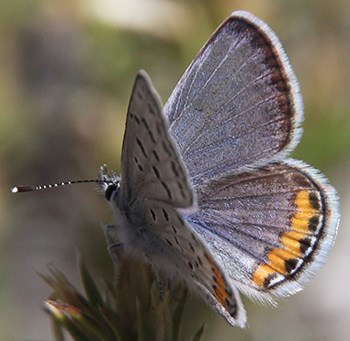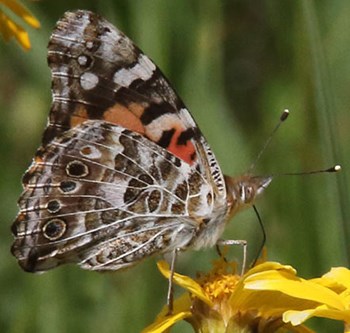
Paul Johnson 
Paul Johnson Yosemite National Park’s rare alpine butterflies flutter at the highest of elevations, where conditions can be extreme. The Sierra Nevada Parnassian butterfly, for instance, is associated with stonecrop growing high in granitic rock gardens. Approximately 60 species of butterflies choose to live with cold winters and short summers at 10,000 feet and higher for one reason: food. In fact, approximately 35 of the 60 species are found exclusively in the high alpine area because they need alpine plants as egg laying sites and food sources for larvae. Different alpine species are associated with unique habitats and often depend on specific plants as egg laying sites and food sources for their larvae. For example, the Sierra Nevada Parnassian (Parnassius behrii) is closely associated with stonecrop growing high in granitic rock gardens and talus slopes. Other species, like the Ivallda Arctic (Oeneis chryxus ivallda), can be found only at the very tops of mountain ridges along the Tioga Crest. Emerging after snowmelt during the Sierra’s warm summer months, most alpine butterflies live for only a short time as adults (2-4 weeks). Their eggs and caterpillar larvae survive the long, cold winters in a state of hormonally-controlled cessation of growth and metabolic processes known as diapause. Scientists believe food sources for alpine butterflies and other alpine animals might be affected by climate change. Climate can affect plant life which, in turn, can affect animal life. Although it is not yet clear how alpine butterflies in Yosemite are responding to climate change, they are a well studied insect group in the park. Alpine butterflies are threatened in many parts of the world because they are rare, exist in small populations and cannot disperse across large distances. Declining butterfly populations may indicate decreased food sources or increased predators, and low populations of butterflies may effect the food chain for birds, spiders, and insects as well as result in decreased pollen dispersal. Due to recent and ongoing climate change, there is great concern that alpine butterflies will decline and begin to disappear. Although it is not yet clear how alpine butterflies in Yosemite are responding to climate change, they are a well studied insect group in the park and information about where and when they were found in the 1930-1960s provides a chance to study changes in their distribution. Additionally, the park is interested in how alpine butterfly populations are interconnected across the Sierra Nevada. Scientists are using genetic methods to characterize the relationships of populations inside and outside of Yosemite National Park. Scientists surveyed alpine butterfly populations through transect counts with nets in 2007 and have conducted additional field surveys in 2008 through a Yosemite Conservancy grant. Because scientists have access to distribution rates going back to the 1930s, they can compare current population changes and the interconnectedness of populations inside and outside the park boundary through genetic methods. Overall, scientists are surveying a large number of Yosemite sites, over multiple years, to collect information on abundance. Some alpine butterflies are no longer found in historical sites within Yosemite National Park and there are very few individuals even when they are found at a site. It is natural for some butterfly populations to disappear and return to particular sites from year to year. However, there has to be a sufficient number of individuals in other populations in order to recolonize sites. Scientists are surveying a large number of sites, over multiple years, and collecting information on abundance to try to understand how the alpine butterflies are doing. Preliminary results from genetic studies suggest that some alpine species have very isolated populations across the Sierra Nevada. This means that they usually do not disperse across large distances and recolonization of large areas might take a long time or may not occur. 
Paul Johnson On a statewide landscape, citizen scientists do the same thing through the North American Butterfly Association’s annual butterfly counts. Trends suggest that alpine butterflies are no longer found in some historic sites or very few exist at a site, confirming that they do not disperse across large distances or have the ability to re-colonize a large area in a short period of time. Part of their biological limitations to reproduce might be that alpine butterflies only live two to four weeks as adults. The butterflies emerge after snowmelt during the warm summer months, and then their eggs and caterpillar larvae must survive long winters in a state or hormonally-controlled cessation of growth and metabolic processes known as diapauses. The presence of the alpine butterfly benefits other creatures in the alpine landscape. Those animals depend on alpine butterflies as a food source. The rarity of butterflies may strain the food chain for birds, spiders, and insects and decrease pollen dispersal. In order to have the best chance to view butterflies, visitors should travel to the high country on a warm, clear day. Use a pair of binoculars or a zoom-lens camera to take a look when they settle on a flower. Information about many rare species of alpine butterflies is often difficult to obtain. If you take a photograph of an unusual butterfly, this could be valuable to park scientists on where and when alpine butterflies are active. E-mail sighting specifics with location details, or fill out a Wildlife Observation Card [38 kb PDF] to report wildlife sightings to the park. More Information
|
Last updated: November 17, 2025
